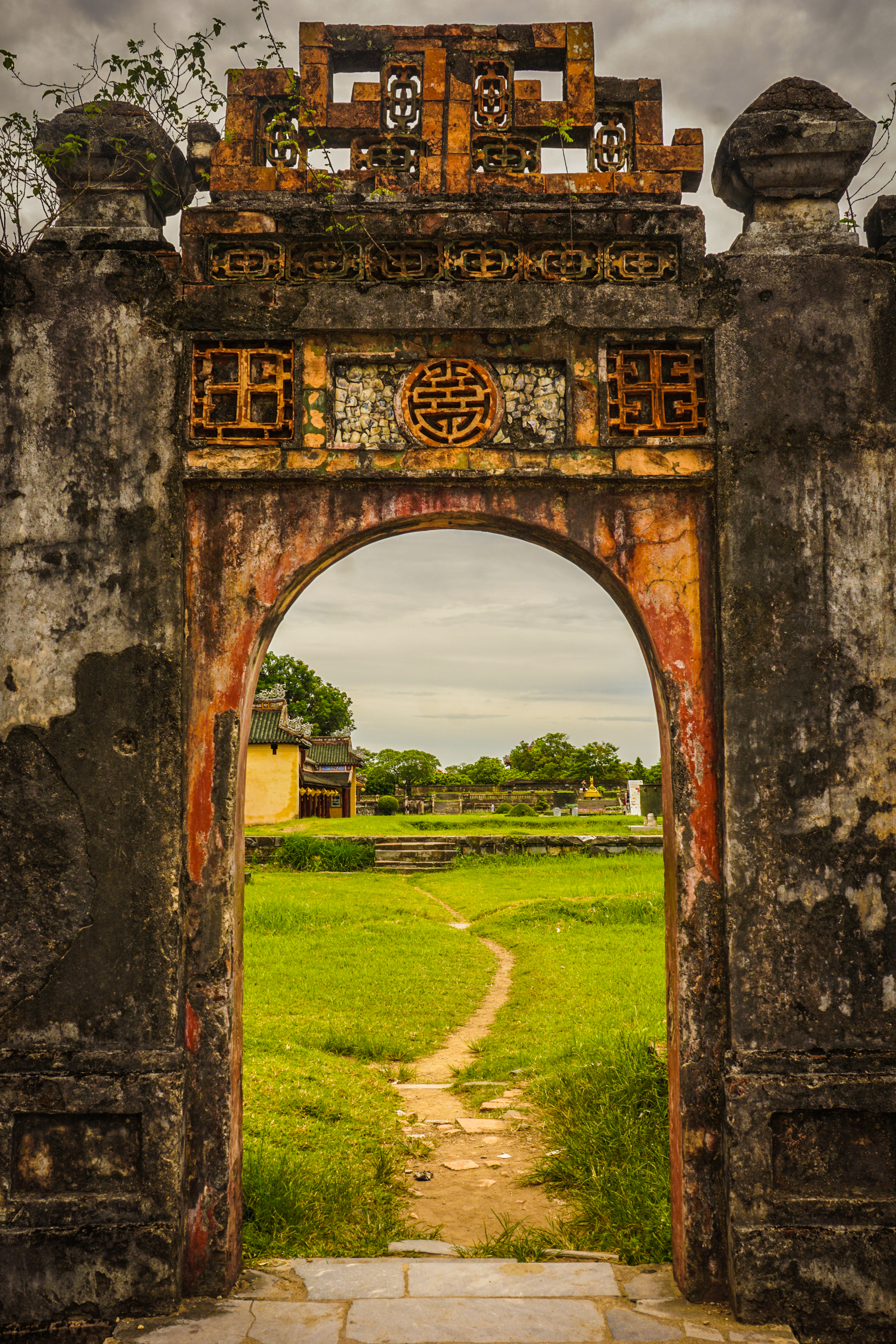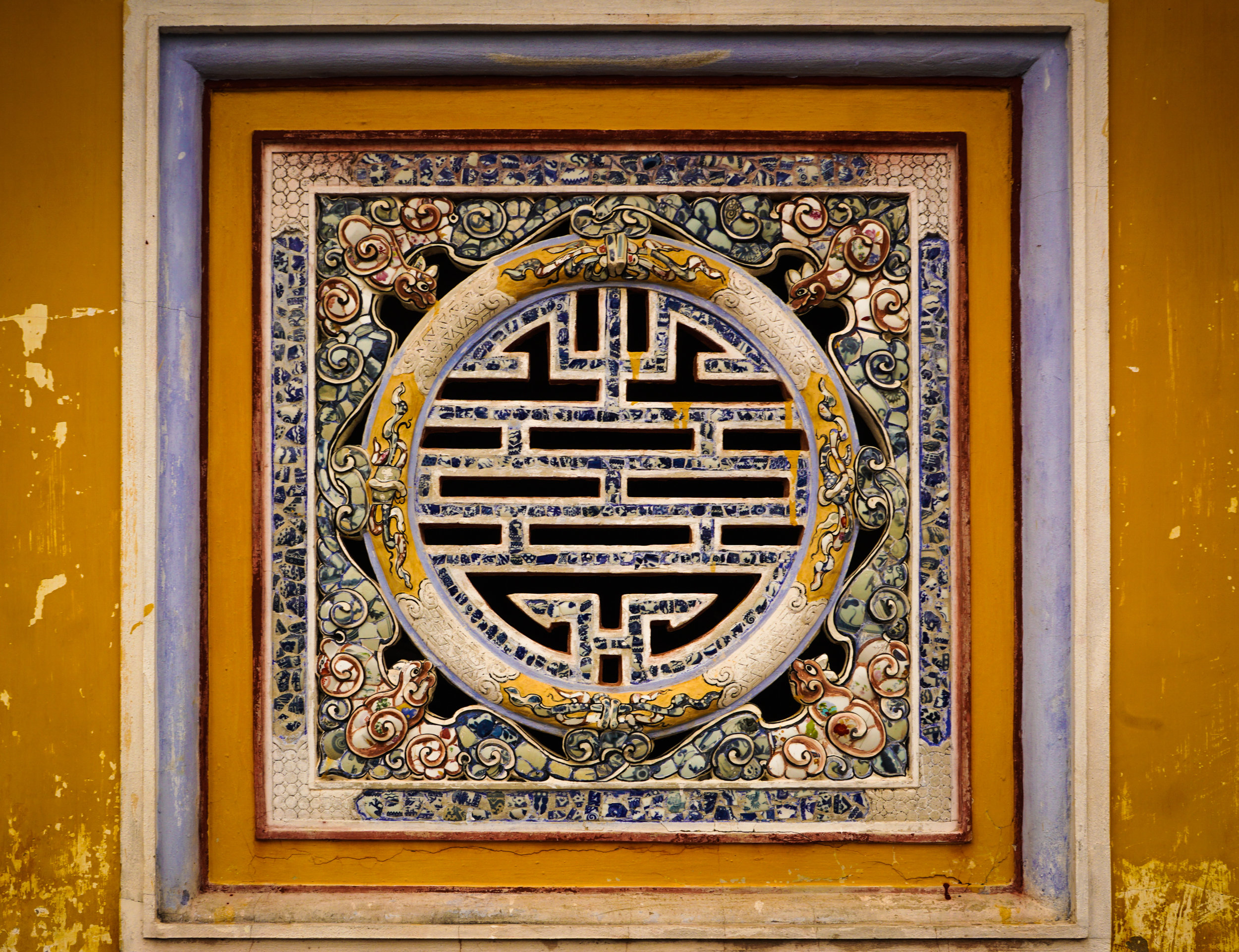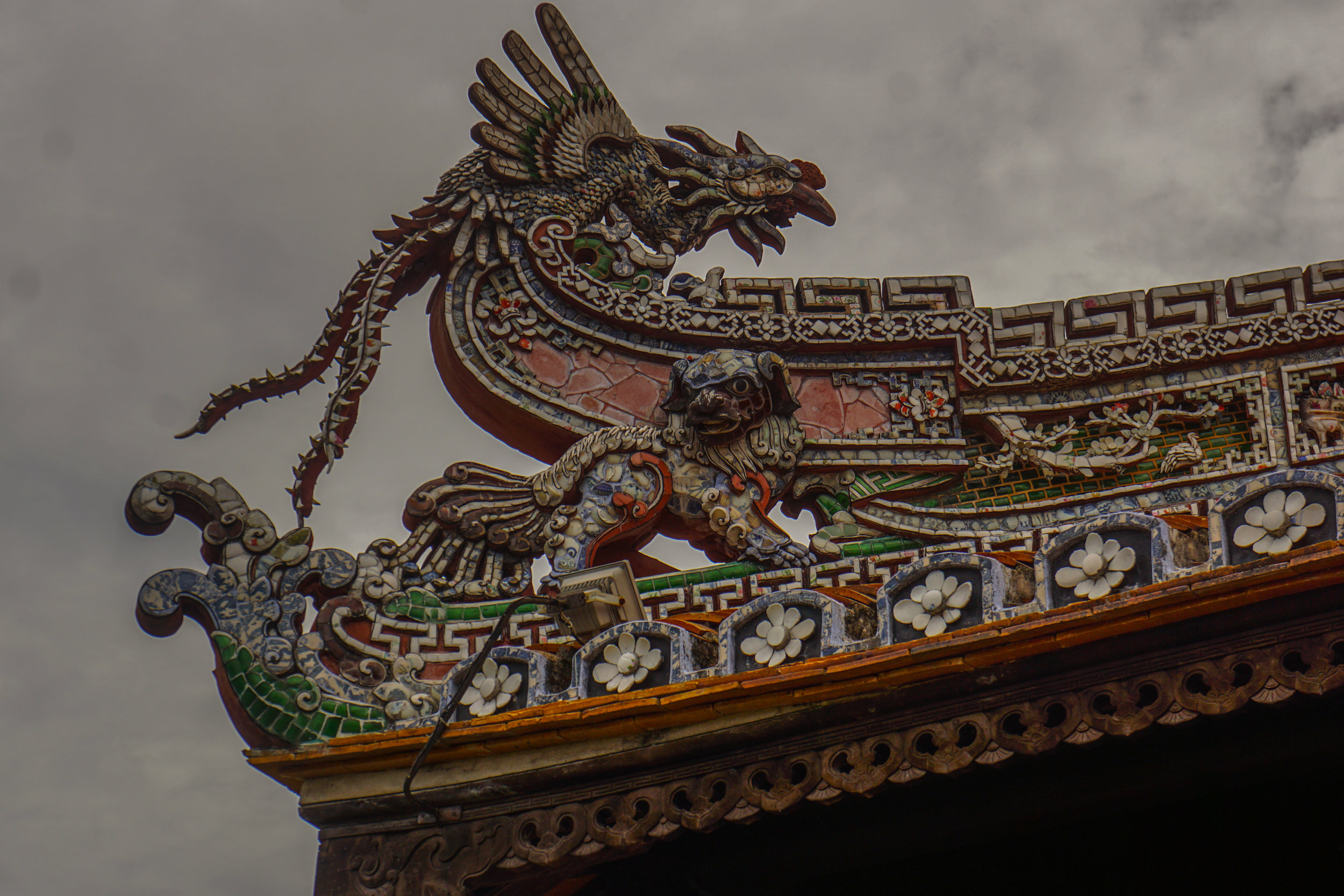A Tale of Two Cities
We only really spent a day and a half in Hue (pronounced “huay”), Vietnam’s Imperial City, but we have a couple of great stories about our time there. Conversely, we spent almost four days in Hoi An, and have almost nothing to say about it. It’s the way that travelling goes, I guess. Sometimes, places excite and reward you in your time there; sometimes, they don’t.
We rolled into Hue with Rachel not feeling very well, but she ponied up and went with me across the Perfume River to the Dong Ba Market. We were on a quest to find a good, authentic bowl of Bun Bo Hue, the famous noodle soup dish from Hue that is universally loved throughout Vietnam, and we weren’t going back to the hotel until we had found it, sick or no.
Little did we know that by the time we left that market, we would be very well fed indeed.
We wandered the clustered stalls of the market for a while, purveying the wares everyone was hawking. In Vietnam, as in most of Asia, their markets are kind of like super compressed shopping malls – you can buy anything you want, from clothes to car parts to electronics to food, and come out with a full belly of delicious food at the end of your shopping spree. We took note of all the fresh fruit and vegetables, without a doubt having just been dropped off from the farm that morning, as well as the clothing on display and the dizzying array of animal parts for sale in the “meat section.” Even though our stomachs turned a little bit at this, we still managed to make our way to the “food court” area, and settle on a Bun Bo Hue stand with an extremely helpful seeming lady at the counter, who seemed very excited to have us sit down and eat at her stand.
This probably should have been our first warning.
We asked for two bowls of Bun Bo Hue, and sat down at the little plastic stools and table that are typical of Vietnamese street eateries, eagerly awaiting our meal.
The first thing that we received on the table was a plate of satays – the lady helpfully peeled the skewered chicken off the little bamboo sticks that they had been roasted on, and put them on our plates. We weren’t really interested in satay, but as the lady had been so nice in giving them to us, and as she was closing shop and probably just getting rid of food she was going to have to throw out anyway, we figured we should do the polite thing and eat them.
Well, the satay was followed by a broth-y soup, three different types of dumplings, some sort of a veggie dish, and a dipping sauce, after which came our Bun Bo Hue, followed by more satay. Us, being morons, were thinking the lady was definitely just being nice, and wanting to be polite, we ate most of everything. Another lady at the stall next to us, likely sensing easy targets, came over and gave us some che, a delicious and sinfully sweet Vietnamese dessert-pudding-drink-thing, made from sugarcane juice, tapioca jelly, and other sweet fruits and beans mixed in.
Note that we only asked for Bun Bo Hue.
HOW DID THIS HAPPEN
Well, after we had eaten enough food to keep a family of four from going hungry for a week, we decided enough was enough. We asked the lady for the bill, and she came back with a tally of 360,000 dong, plus 40,000 for the che.
For some perspective on this, typically, two bowls of noodle soup would cost you around 40-80,000 dong at most street stands. We were charged for every satay we ate (including the ones that she took off the damn sticks and put on our plates!), every dumpling, and some che we didn’t ask for or even want. So we ended up paying around five or six times what we had intended.
Again, note that we only asked for Bun Bo Hue.
Granted, 400,000 dong is still only like $18 USD, but if you were intending on going out and having a $3 meal it still comes as a bit of a sticker shock. But, we did eat all of it, and we didn’t negotiate a price beforehand, so we opened our wallets and paid the woman, then briskly walked out of there with our tails between our legs.
Lesson learned – in Vietnam, always negotiate your price beforehand.
We walked back to the hotel across a pretty iron bridge, built by the French and designed by none other than the famous architect and engineer Gustav Eiffel, and strolled along the lantern-lit riverbank. We were eventually stopped by a group of students who wanted to practice their English, so we sat with them for a while and talked about Vietnam and our lives. They told us about a free walking tour that went on every day that we should attend, and we thanked them and finally made our way back to the hotel so Rachel could attempt to sleep off her illness.
Despite Rachel still not feeling 100%, the next morning we woke up, grabbed breakfast, and met up with the free walking tour. Our guide told us all about the recent and ancient history of Hue, and we followed him from the ‘hotel quarter,’ where we initially met, all the way to Quang Truong Ngo Mon. Our tour guides and everyone else on the tour were going to get some lunch, but Rachel and I decided that, as we were at the gates already, we might as well go visit Vietnam’s Imperial City, and find out more about the mysterious emperor that resided there for hundreds of years.
Walking through historical halls...
The first emperor of early Vietnam was someone that I mentioned in previous posts about Hanoi – the man with the magic sword, Le Loi. Le Loi drove the Chinese from Vietnam in a popular, but brutal and surprisingly quick war of independence in the 1400’s. However, even though the Chinese were gone (and the bad blood still exists, even to this day), they left and have continued to leave an indelible cultural impression on the Vietnamese, including things like Confucianism, the Chinese feudal system, and the design of the Imperial City in Hue. Although the dynasty that built the Imperial City came quite a bit after Le Loi (like 400 years or so), they ordered their workers to recreate the Chinese Imperial City’s grandeur as a fitting home for the first emperor of the Nguyen Dynasty.
Anyone who has been to the Forbidden City in Beijing would be immediately familiar with the layout of the Imperial City in Hue. There are three walled cities here, each one within the other like a Russian nesting doll. The first wall contains the Citadel, where the innermost city of Hue was originally located. The site was chosen with careful consideration to the Feng Shuai of the surrounding mountains, Perfume River, and lowlands that surround it. Within that, the second wall contained the Imperial City, inhabited by the Emperor’s mandarins (Vietnamese and Chinese equivalents of lords, landowners, and scribes), the people who more or less ran the country for him. The third wall contains the Purple Forbidden City, accessible only the emperor himself, his wives and concubines, his direct family, and his servants as necessary. It was thought that the Emperor of Vietnam was a semi-godlike figure, and this third city was his heavenly realm, though as of now he hasn’t resided there for many, many years.
The story of the fall of the Emperor of Vietnam is a bit of a sad one. Once revered by the people, the feudal system that he ruled under was ruthlessly exploited by the colonial French, and he became nothing more than a puppet regime to the French Governor. After seeing their once-beloved emperor bend his knee to the hated French, and realizing his obvious lack of heavenly decree, the people began to turn against him and his mandarin servants during this colonial period, culminating in the last Emperor of Vietnam, Bao Dai, stepping down to the brief Democratic Republic of Vietnam, a post-WWII government set up by Ho Chi Minh in Hanoi. They abolished his office immediately, preferring that the people would rule Vietnam, not an emperor, and renamed him ‘supreme advisor’ to the Viet Minh government.
Not a ton left of this grand old lady.
The palace lasted slightly longer than the Nguyen dynasty itself, but it was extensively damaged by the Allied (American & South Vietnam) response to the 1968 North Vietnamese Tet Offensive. Of the 150+ major buildings in the Palace complex, only ten or so survived the American bombs. Since then, however, much of the complex has been lovingly restored by historians and patrons of history, and it was a fascinating place to walk around and enjoy the day.
After getting enough sunshine and history, and with Rachel feeling increasingly queasy as the day wore on and the heat returned in force, we returned to the room to rest up for our ride over the Hai Van Pass the next day.
We already spoke about the Hai Van Pass in detail on the “The Road, Part II” post, so we won’t go into any detail about it here. We will, however, note that the ride into Hoi An was beautiful but longer than we expected, so we were probably more excited than we anticipated getting into the Sun Boat Hotel (recommended) that afternoon. However, we weren’t too tired to take Michael J. Fox into town that night and check out the infamous ‘Hoi An Ancient Town.’
Riverboats outside of our hotel.
Lights, camera, ACTION
There are two things that Hoi An is known for: tailors, and the Ancient Town. The Ancient Town has been an important trade hub since around the seventh century AD, and as such has had eclectic influences from Vietnam, Japan, China, India, Portugal, and France, among others, but it was the tailoring that really brought us here. Rachel needed a dress made for a wedding in which she’s part of the bridal party, so we decided that making a stop here would be prudent. We have to say, we were treated very well by Yala Couture in town, and would highly recommend that anyone in the area go and get their tailoring done there.
I like this picture so much I put it on here twice and I'm not even a little sorry.
The other thing Hoi An does really, really, well is silk lanterns, and it’s arguably why the Ancient Town is so legendary for people coming to visit Vietnam. Walking through cobblestone streets and over its many canals, lit by silk lanterns and floating candles, with shops hawking goods and gondoliers steering their boats, you feel like you’ve stepped back into time into a more romantic era; if it weren’t for the thousands of tourists thinking the same thing, it’d be perfect.
Beautiful lady in a beautiful old town.
Beach crabs.
The crowds, and the fact that nothing really worked out for us, were the reasons we didn’t have as many stories to report on Hoi An as we thought we would. On a couple occasions, the activities that we had planned downright failed us – we tried to do both a bike tour and a photography course while in town, and both companies neglected to get back to us after rigorous contact attempts (and even one confirmation). This unfortunately kyboshed a couple of mornings which we were really looking forward to in our time here. Furthermore, our transportation for the next leg of the journey, a bus trip taking the motorbikes and ourselves down to Nha Trang, never did due to our indecisiveness and the shitty FutaBus website, so we had to high-tail it to Da Nang on our final day here in order to get transportation out, which was annoying to say the least.
I mean, no photography course, sure, but we do take some decent photos...
The morning catch.
There were, however, a few things that we did manage to get right while in Hoi An, other than some errands and the aforementioned tailoring; we had our first beach day since Thailand at An Bang beach, just a few kilometers out of town, and had some fantastic seafood out there to boot; we met a local expat named Randy, who owned a shop in town called Randy’s Used Books; we ate three Hoi An specialty dishes – Cao Lao (thick rice noodles with crispy pork), Mi Quang (thick rice noodle soup), and Ban Cao Vac (White Rose Dumplings), as well as some sandwiches at Anthony Bourdain’s favorite Banh Mi place, Banh Mi Phuong; we did a gondola ride up the main canal and let some little paper lanterns go with our best wishes alongside the boat; we went out to a fishing village VERY early one morning to see all the commotion of the morning catch – the fisherfolk start their days well before sunrise, which is around 5:30 in this part of the world; and we managed to beat the heat with some pool, relax time, and several games of rummy (none of which I won).
Maxin' relaxin outside of the pool.
I taught the mechanic's son to use Rachel's camera. He doesn't have a future as a photographer.
So, although Hoi An let us down in some ways, we still managed to seize the day with others, and we left Hoi An excited about our next prospects. That excitement was short-lived however, as DJ Khaled decided to give up on the way to Da Nang about ten times before we finally got wise, roused a mechanic from his dinner, and replaced the spark plug. We finally made it to the city of Da Nang later that night, and were just happy we got out without anything else going wrong. The next day, we were putting the bikes on a bus and making our way down the coast to the city of Nha Trang, where we’d be disembarking and riding up to Da Lat. Cool weather and good food were calling!
























